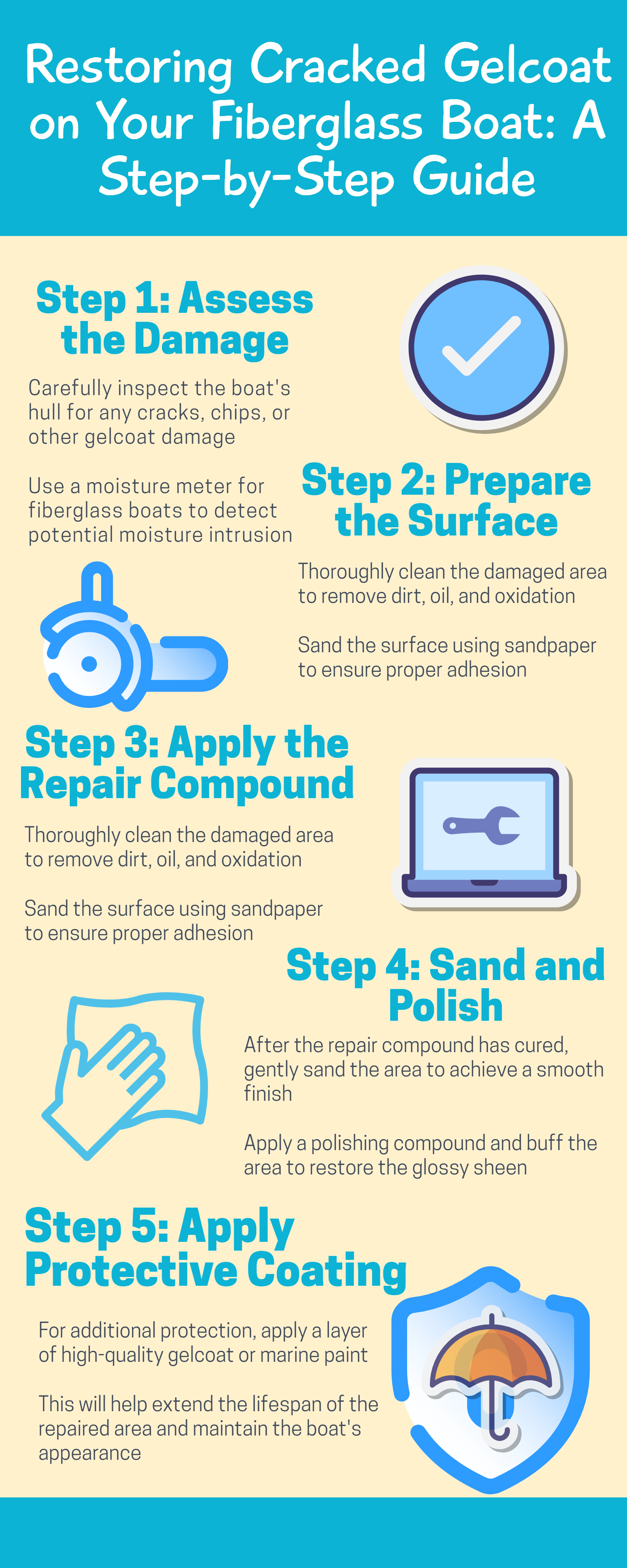Quick Tips
- Cracked gelcoat on boat? Regularly clean and wax your fiberglass boat
- Cracked gelcoat on boat? Inspect for gelcoat cracks and stress cracks
- Cracked gelcoat on boat? Address minor repairs promptly to prevent further damage
- Use proper storage techniques to protect your investment
- Consider professional help for major refinishing projects
[BUTTON: Find Fiberglass Boat Maintenance Services near you]
Introduction
As a proud fiberglass boat owner, you understand the importance of proper maintenance and care to ensure longevity and performance. However, even with good care, time and weather can lead to issues like cracked gelcoat on boat, necessitating repairs. This guide will help you become an expert in preserving fiberglass boats, covering routine maintenance and refinishing techniques.
Fiberglass boat maintenance: Fiberglass Boat Upkeep and Refinishing Uncovered
Gelcoat Repair and Fiberglass Boat Maintenance: Your Questions Answered
Understanding Fiberglass Boat Construction
The Anatomy of a Fiberglass Boat
Fiberglass boats are constructed using a combination of fiberglass-reinforced plastic (FRP) and a protective outer layer known as gelcoat. The gelcoat provides a smooth, glossy finish and is the first line of defense against environmental factors. The boat’s structure consists of several layers of fiberglass cloth or mat soaked in resin, providing exceptional strength and durability.
Common Issues and Their Causes
Over time, fiberglass boats can face various issues, including:
- Gelcoat degradation
- Stress cracks in fiberglass
- Fiberglass delamination
- Fiberglass boat hull damage
Regular inspections, including visual checks and using a moisture meter for fiberglass boats, can help identify areas of concern early on, including cracked gelcoat on boat.
[CATALOG_LINK: Find Fiberglass Boat Inspection Services near you (Boat Repair and Maintenance)]
Mastering Routine Maintenance
Cleaning and Waxing
Regular cleaning and waxing are crucial for preserving your fiberglass boat. Use fiberglass boat cleaners specifically formulated for these surfaces. Apply a high-quality marine wax at least twice a year to protect against UV rays and environmental pollutants.

Inspecting for Potential Issues
Regularly inspect your boat for:
- Gelcoat cracks, including cracked gelcoat on boat
- Chips in fiberglass
- Signs of fiberglass delamination
- Areas where the gelcoat has lost its luster
Use a moisture meter for fiberglass boats to identify any moisture intrusion that may cause structural problems.
Navigating Fiberglass Boats Purchases: Your Comprehensive Buyer’s Companion
Addressing Minor Repairs and Refinishing
Gelcoat Repair and Restoration
For minor gelcoat cracks or chips, including cracked gelcoat on boat, use a gelcoat repair kit. These kits typically include gelcoat paste, hardeners, and application tools. For more extensive damage, consider fiberglass boat refinishing, which may involve:
- Sanding the gelcoat
- Applying a new layer of gelcoat or marine paint
- Buffing and polishing for a like-new appearance

Addressing Structural Damage
For more significant issues like stress cracks or delamination:
- Grind out the damaged area
- Apply fiberglass cloth and epoxy resin
- Finish with gelcoat or marine paint
Consider seeking professional help for extensive or complex repairs, including those involving cracked gelcoat on boat.
From Hull to Helm: Analyzing Expenses for Your Dream Fiberglassing boat
Comprehensive Refinishing
The Refinishing Process
A full refinishing process typically involves:
- Sanding down the entire hull and deck
- Repairing any cracks or damage, including cracked gelcoat on boat
- Applying a fresh gelcoat or marine paint
- Buffing and polishing to a high-gloss finish
The Buyer’s Guide: Addressing Common Queries for Fiberglass Boats

Choosing the Right Products and Tools
Invest in high-quality fiberglass boat refinishing supplies, including:
- Marine-grade sandpaper
- Gelcoat or marine paint
- Buffing compounds
- Polishing tools
- Fiberglass boat buffer machines
[CATALOG_LINK: Browse Fiberglass Boat Refinishing Supplies (Boat Repair and Maintenance)]
Protecting Your Investment
Establishing a Maintenance Routine
Develop a regular maintenance schedule that includes:
- Cleaning and waxing the hull and deck
- Inspecting for new issues, including cracked gelcoat on boat
- Promptly addressing any problems
Consider investing in fiberglass boat covers or storage solutions for added protection.
Proper Storage Techniques
When storing your fiberglass boat:
- Use a fiberglass boat storage cover or storage box
- Ensure proper ventilation to prevent moisture buildup
- Consider using a dehumidifier or moisture absorber
- Apply bottom paint or antifouling coating for boats stored in water
Demystifying Fiberglass Boat Repair Services: A Comprehensive FAQ Guide
Common Mistakes to Avoid
- Neglecting regular cleaning and waxing
- Ignoring minor cracks or chips in the gelcoat, including cracked gelcoat on boat
- Using harsh chemicals or abrasives on the fiberglass surface
- Failing to address moisture intrusion promptly
- Attempting major repairs without proper skills or equipment
Conclusion
Mastering fiberglass boat preservation requires patience, attention to detail, and a commitment to regular maintenance. By following this guide and staying proactive in your boat’s care, you can ensure its longevity, performance, and beauty for years to come. Remember to seek professional help when needed and always prioritize safety in your maintenance and repair efforts, especially when addressing issues like cracked gelcoat on boat.
[BUTTON: Find Fiberglass Boat Maintenance and Repair Services near you]
Additional Resources
- Unraveling the Expenses: Fiberglass Boat Restoration Unveiled fiberglass boat repair cost
- Mastering Fiberglass Vessel Care: Your Questions Answered
- The Buyer’s Guide: Addressing Common Queries for Fiberglass Boats
[CATALOG_LINK: Browse Fiberglass Boat Maintenance Services in your area (Boat Repair and Maintenance)]

